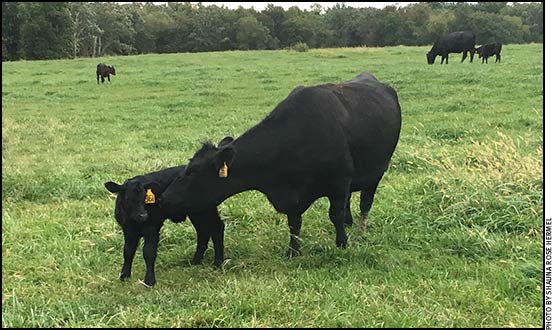HEALTH & NUTRITION...

Expert Warns Screwworms Could Have Huge Impact on Livestock
Southern and Southwestern cattlemen on high alert after screwworms are discovered in Florida.
The return of screwworms would deal a severe blow to the ranching and hunting industries, said a Texas A&M AgriLife Extension Service veterinary entomologist at Stephenville.
The observation by Sonja Swiger came as the result of the flesh-eating pest being confirmed in Florida.
Swiger said Thomas Hairgrove, AgriLife Extension veterinary specialist at College Station, gave a presentation to producers Oct. 7 at Stephenville during which he said the cost to control the pest today in cattle alone could easily exceed $500 million annually.
“Dr. Hairgrove also mentioned a price tag of $1 billion would be needed annually to eradicate screwworms from their former range, should it become re-established,” she said. “Some in attendance at Dr. Hairgrove’s presentation had no idea of the gravity of the issue. That’s understandable, as the last reported case in the United States was decades ago.” Read more.
Pay Attention to Vaccine Storage
Make sure your refrigerator’s performance is up to the task of storing vaccines.
Vaccines are biological products that need to be kept within a certain temperature window to remain potent through their expiration date. Most of them need to be refrigerated and kept cool, but not frozen. Freezing may alter them and render them useless or, in some cases, change the composition and make them dangerous.
“Producers also need to take a look at where and how they are storing/handling their vaccine while working cattle,” according to Shannon Williams, extension educator of agriculture and natural resources at the University of Idaho. “I’ve seen instances where people are refilling their syringes and the lid is off the cooler and it is right by the branding fire, or sitting in the sunshine rather than in the shade,” says Williams.
Read more.
Feeding Newly Weaned Calves
K-State specialist gives tips to improve feed consumption by newly weaned calves.
As spring beef calves are beginning to be weaned, it is the producer’s responsibility to help make that transition as smooth as possible. Improper weaning can result in poor growth, which may stay with the animal throughout its life, according to Kansas State University (K-State) animal scientist Justin Waggoner.
“I break down the weaning process into three stresses the calf is dealing with,” said Waggoner, who is a beef systems specialist with K-State Research and Extension. The first and most obvious is maternal separation; the second is moving to a new environment and social structure; the third is the need for a calf to become accustomed to new and unfamiliar feedstuffs as it’s transitioned from a diet of grass and milk to a total mixed ration or starter pellet in a different environment. Read more.

Rick Rasby
Ridin’ Herd
Supplementing cows grazing corn residue.
There are some corn residue fields that should not be grazed by livestock due to topography/landscape and/or corn grain yield, but there are very few of those fields in Nebraska. Another concern is animal performance from grazing residue that has been genetically enhanced. Residue grazing is an important management practice for many cattle operations as either a winter feed resource for maintaining the breeding herd or putting weight on cull cows. Spring-born calves weaned in the fall can be wintered on corn residue using supplementation to achieve targeted gains. Read more.
Feed the Herd, Not the Parasites
Fall deworming helps decrease parasite load and protects the reproductive performance of the herd.
When it comes to keeping breeding stock healthy and performing, many producers automatically lean toward reproductive vaccines. However, vaccines aren’t the only herd health protocol that can help ensure the reproductive performance of a herd, according to Gary Sides, managing nutritionist, Beef Strategic Technical Services at Zoetis.
Read more.
Benefits of Being Able to Perform a Necropsy
Veterinarians can serve as educators for stockmen.
If an animal dies and the cause of death is unknown, it’s often wise to perform a necropsy to try to determine what happened, especially if a change in management could eliminate the risk for further deaths in the herd. A postmortem examination might determine whether the animal died from hardware, pneumonia, poisoning or some other problem that might be preventable. If there’s a disease in the herd, a parasite problem or nutritional deficiency that the producer has not been aware of, a necropsy can be a useful tool for helping solve a problem and finding ways to improve health management.
David Van Metre, associate professor and extension veterinarian at Colorado State University, says that being a university hospital-based clinician sometimes makes it difficult to formulate prevention strategies when he only sees sick animals at the clinic and a dead calf now and then. Read more.
Proper Nutrition for Wintering Cows Can Pay Dividends Long-term
Sample at least 10% of hay bales when determining supplementation rates.
Providing forage and feed supplies with the proper nutritional value for cows is an important consideration for producers as winter approaches, said Jason Banta, Texas A&M AgriLife Extension Service beef cattle specialist, Overton.
Testing hay for quality can provide information producers need to meet the nutritional requirements of cows and keep them in good condition through the winter, Banta said.
By determining the hay supply’s crude protein content and total digestible nutrients, or TDN, which is the measurement of available energy in the forage, producers can determine whether supplemental feed will be necessary, Banta said. Knowing what type and how much supplemental feed is needed can save producers money long term.
Read more.
Cattle Diseases: Common Conditions/Terms
Click here for a list of common conditions and terms related to beef cattle diseases, such as anaplasmosis, brucellosis, BVD, E. coli, IBR and others.
[Click here to go to the top of the page.]






